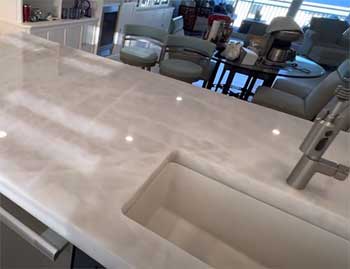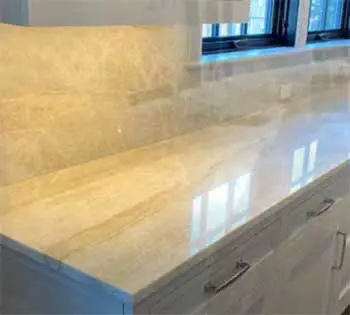When it comes to kitchen countertops, two premium options stand out from the pack: Caesarstone and quartzite. Both offer high durability, stylish looks, and an upscale vibe. But some key differences might make one better suited for your home than the other.
In this comprehensive guide, we’ll compare Caesarstone and quartzite countertops to help you decide which is right for your next remodel or new construction project.
We’ll look at the pros and cons of each material, differences in appearance, maintenance needs, cost considerations, and more.
A Brief Comparison Table
| Feature | Caesarstone | Quartzite |
| Composition | 93% crushed quartz aggregate mixed with resins and pigments | 100% natural metamorphic rock |
| Appearance | Consistent color and pattern options | Unique natural veining and patterns |
| Durability | Very durable and scratch-resistant | Extremely hard and scratch-resistant |
| Heat Resistance | Can withstand moderate heat | Withstands very high heat |
| Porosity | Non-porous | Low porosity |
| Maintenance | Low maintenance | Moderate maintenance required |
| Cost | $50-$120 per square foot installed | $70-$200 per square foot installed |
Now let’s dive deeper into each category to understand the key differences between these two premium countertop materials.
In-depth Differences Between Caesarstone And Quartzite Countertops

- Composition
The most significant difference between Caesarstone and quartzite is their composition.
Caesarstone is an engineered quartz surface made from roughly 93% crushed quartz aggregate combined with resins and pigments. The resins bind the quartz particles together into a durable slab.
Caesarstone slabs are manufactured in factories under tightly controlled conditions for consistent quality and appearance.
Quartzite, on the other hand, is a 100% natural metamorphic rock formed deep within the earth’s crust. It begins as natural quartz sandstone which gets compacted and heated over millions of years, transforming it into an extremely hard and durable material.
Each quartzite slab has a completely unique natural pattern and coloring.
So Caesarstone offers manmade consistency, while quartzite provides natural stone variation.
- Appearance
The composition difference leads to distinct visual characteristics between the two materials.
Caesarstone comes in a wide range of consistent colors and patterns. The pigments mixed in during manufacturing give Caesarstone an even, uniform look.
Subtle patterns can be added to mimic natural stone, but the overall appearance is more homogeneous than natural stone. The consistent quality allows for seamless appearance across the countertop surface.
Quartzite countertops showcase natural veining, crystallization, color variations, and other markings that give each slab a one-of-a-kind aesthetic. Since it is natural stone, no two slabs will ever look the same.
The random patterns and striking natural beauty set quartzite apart in terms of visual appeal.
- Durability

Both Caesarstone and quartzite rank at the top end of the scale when it comes to countertop durability.
Caesarstone is composed of over 90% quartz, one of nature’s hardest minerals, giving it exceptional strength and durability.
The engineered material is non-porous, scratch-resistant, stain-resistant, and can stand up to heavy daily use for years.
Caesarstone is not completely indestructible, but it is remarkably tough and durable for a countertop surface.
Quartzite rates a 7-8 on the Mohs hardness scale, even harder than granite. The metamorphic composition gives quartzite superior durability and scratch resistance compared to most natural stone countertops.
It can stand up to heavy impacts without chipping or cracking. The low porosity also makes quartzite highly resistant to stains and etching from acidic foods or cleaners.
Both offer excellent durability that can last for decades with proper care. Quartzite rates ever so slightly harder and more scratch-resistant. But Caesarstone isn’t far behind, performing better than most other engineered and natural stone options.
- Heat Resistance
Here is where quartzite clearly surpasses Caesarstone in terms of performance.
Caesarstone can withstand moderate heat, but prolonged direct exposure to very hot pots and pans can potentially damage the resin binders in the stone. Using trivets or hot pads is highly recommended.
While Caesarstone is heat resistant compared to other engineered surfaces, it does not do well with extreme sustained heat.
Quartzite is nearly impervious to heat damage, even when exposed directly to very hot cookware or bakeware fresh out of the oven. You can take a casserole straight from a 425-degree oven and set it on a quartzite countertop without worries.
This superior heat tolerance makes quartzite an ideal choice for avid home chefs and bakers.
- Porosity
When it comes to porosity, Caesarstone and quartzite once again both perform well, with quartzite rating slightly better.
Caesarstone is non-porous, giving it excellent stain resistance and low maintenance needs. Liquids and spills sit on top rather than absorbing into the material’s surface. Caesarstone’s lack of porosity contributes to the durability and longevity of the countertops.
Quartzite has very low porosity, although not quite zero like Caesarstone. The metamorphic composition and mineral deposits fill in pores found in natural quartz. But small pits and fissures in some quartzite can allow a minimal amount of penetration.
Overall though, its low porosity makes quartzite highly resistant to stains and etching.
- Maintenance
Living up to its reputation as an easy-care countertop material, Caesarstone requires very little regular maintenance. Since it is non-porous, you only need to use a damp cloth or mild detergent to wipe away most dirt and grime buildup.

No sealing or polishing is required.
Just avoid abrasive cleaners that could dull the surface.
Caesarstone is simple to clean and maintain day-to-day.
Quartzite’s low porosity also ensures minimal maintenance needs.
But since it is still natural stone, quartzite does require a bit more care and upkeep than Caesarstone.
Use a stone cleaner and sealer every 1-2 years to maintain the protective barrier.
This keeps quartzite looking like new and prevents etching or staining from recurring over time. More frequent cleaning is needed than with Caesarstone. But quartzite remains far easier to maintain than marble, granite, or other natural stones.
- Cost
As premium countertop options, neither material comes cheap. Expect to pay $50 per square foot installed for lower end Caesarstone options, up to $120 per square foot for rare or exotic designs. The average cost lands around $70 per square foot installed.
Quartzite sits at the higher end of the natural stone price range. Lower grade quartzite may cost about $70 per square foot. But the most desirable, top-tier varieties run $120-$200 per square foot installed. The average falls around $100-150 per square foot.
The takeaway: Caesarstone offers greater affordability, while premium quartzite sits at the top end of the price range.
Pros and Cons of Caesarstone Countertops
Pros:
- Highly durable and scratch resistant
- Stain resistant
- Non-porous
- Low maintenance
- Consistent colors and patterns
- Manufactured for reliable quality
- More affordable than natural stone
- Can mimic look of granite, marble, and more
- Seamless appearance possible across countertops
Cons:
- Less heat resistance than natural stone
- Limited to manufactured colors and patterns
- Lower resale value than quartzite
- Can chip or crack if subjected to strong impact
- Not completely indestructible
Pros and Cons of Quartzite Countertops
Pros:
- Extremely hard and scratch resistant
- Withstands very high heat
- Resists staining and etching
- Natural uniqueness of each slab
- Gorgeous veining and crystallization
- Durable and long-lasting
Cons:
- Needs periodic sealing
- Slightly more prone to etching than Caesarstone
- Expensive
- Limited supply and availability
- Doesn’t offer manufactured colors or patterns
- Porosity necessitates more maintenance
- Chips, cracks possible but repairable
Caesarstone Vs. Quartzite: Which Is Better For Your Home?

Now that we’ve compared the two premium countertop contenders in detail, how do you choose which material is right for your kitchen or bath remodel?
Here are a few key factors to consider:
- Budget – Caesarstone is the more affordable option
- Cooking needs – Quartzite handles high heat better
- Visual appeal – Quartzite provides natural beauty, Caesarstone offers colors/patterns
- Maintenance – Caesarstone needs less regular upkeep
- Durability – Both extremely durable, quartzite rates slightly harder
Caesarstone lends itself well to contemporary, modern, or minimalist kitchen designs where sleek, consistent surfaces are desired. Quartzite delivers unparalleled natural beauty perfect for adding organic elegance.
Both offer quality and durability far surpassing laminate, tile, or solid surface countertops. While pricing is on the higher end, either is a smart long-term investment that can significantly boost your home’s functionality and visual appeal for decades to come.
When in doubt, consult with an experienced countertop fabricator. They can help you select the ideal material, colors, and patterns to achieve the aesthetic and performance you desire within your budget.
This will ensure you get the perfect countertops to match your lifestyle and design vision.
Frequently Asked Questions (FAQ)
Below are answers to some common questions about quartzite and Caesarstone countertops:
No, Caesarstone is generally the more affordable option. Low-end Caesarstone starts around $50 per square foot installed, while inexpensive quartzite may cost $70 per square foot. On the higher end, exotic quartzite can cost over $200 per square foot – significantly pricier than Caesarstone.
Caesarstone is regarded as a top quality quartz countertop brand. It offers exceptional durability, stain resistance, low maintenance needs, and a wide range of color/pattern options. But other brands like Cambria and Silestone also make excellent engineered quartz countertops. Caesarstone stands out for its reputation, quality, broad selection, and reasonable prices compared to other quartz brands.
The disadvantages of quartzite include:
1. Expensive, especially for premium varieties
2. More prone to etching than engineered quartz
3. Requires periodic sealing
4. Limited supply and availability
5. Won’t have precise uniform colors like engineered quartz
6. Natural stone means more maintenance than Caesarstone
Quartz (engineered) countertops like Caesarstone offer greater consistency, affordability, low maintenance needs and a broad range of colors. Quartzite (natural) costs more but provides unmatched natural beauty, higher heat tolerance, and increased hardness/scratch resistance. Quartzite must be sealed periodically. For most homes, engineered quartz like Caesarstone offers the easier maintenance and better value. But quartzite’s durability and appearance make it ideal for some luxury kitchens.
Final Thoughts
There’s a reason Caesarstone and quartzite stand at the pinnacle of countertop choices. Both offer long-lasting durability and visual appeal.
By understanding their composition, performance differences, care needs, costs, pros and cons – you can determine which premium surface is the ideal choice for your next kitchen or bath remodel.
Consult with an expert, evaluate your budget and design goals, and you’ll end up with gorgeous, functional countertops that will serve your home beautifully for decades to come.
